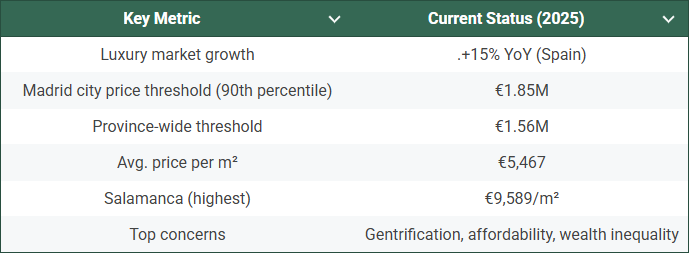🏙️ Madrid Real Estate Soars: Luxury Home Prices Up 28% in One Year
Madrid is solidifying its status as one of Europe's hottest luxury real estate markets. According to Idealista’s June 2025 report, prices in the top 10% of Spain’s housing market rose by 15% in the past year — with Madrid leading the charge at an eye-popping 28% increase in the capital and 30% across the province.
Madrid’s Prime Property Market Surges
-
In Madrid city, homes in the top 10% (90th percentile) start at €1,850,000, second only to Palma de Mallorca.
-
The Madrid province follows closely with a threshold of €1,560,000, placing it behind the Balearic Islands (€2,950,000) and Málaga (€2,200,000).
Nationwide Context
-
Only Oviedo (+43%) and Guadalajara (+35%) have exceeded Madrid’s price growth among Spanish capitals.
-
In contrast, Barcelona’s luxury housing saw a much lower increase of just 8%.
The Golden Triangle of Madrid’s Luxury Real Estate
Salamanca, Chamberí & Retiro: Price per Square Meter Hits New Heights
As of April 2025, the average home price in Madrid reached €5,467/m², a historic high with an annual growth of 24.3%.
Top luxury districts:
-
Salamanca: €9,589/m² (+25.9%)
-
Chamberí: €7,871/m²
-
Retiro: €7,208/m²
By contrast, outer districts like Villaverde or Usera remain around €2,300–€3,000/m², highlighting the city’s growing housing inequality.
El Viso: Madrid’s Ultra-Prime Neighborhood
Homes in El Viso, one of Madrid’s most exclusive areas, typically start at €3.5M, often surpassing €7–8M after high-end renovations. It remains the benchmark for ultra-luxury living in the city.
New Build Luxury Sets Record
According to Colliers, luxury new developments in Madrid have reached a staggering €27,429/m², setting a new record. Branded residences linked to top hotel names like Four Seasons and Mandarin Oriental are driving this trend.
Why Is Madrid’s Luxury Real Estate Booming?
1. Strong International Demand
Madrid continues to attract high-net-worth individuals from Latin America, the U.S., Russia, and Asia. Key drivers include:
-
Favorable tax regime (no wealth tax for non-residents)
-
Investor-friendly visa policies (“Golden Visa”)
-
High quality of life, safety, climate, and global connectivity
2. Supply Shortages
A persistent lack of new housing construction, especially in high-demand areas, is creating upward pressure on prices.
3. Real Estate as an Investment Asset
Institutional investors, REITs, and private equity firms are increasing their foothold in Madrid’s residential market, viewing property as a safe, appreciating asset.
4. Gentrification of Traditional Districts
Urban transformation projects, particularly in Arganzuela and Tetuán (home to Skyline Madrid), are turning formerly working-class neighborhoods into luxury hotspots — displacing long-time residents and reshaping the city.
What Does This Mean for Locals?
-
Decreasing Affordability: Prices in Madrid have risen over 15% in the first half of 2025 alone, making homeownership increasingly inaccessible.
-
Widening Wealth Gap: Since 2015, home prices have climbed by 47%, while wages have increased only 17% — deepening economic disparities.
-
Social Impact: Younger generations are delaying homeownership or leaving the city altogether due to high housing costs.

Outlook: Boom or Bubble?
With a mix of foreign capital, luxury demand, and tight supply, Madrid appears to be consolidating itself as a top-tier luxury property market. But risks remain. As prices decouple from local income levels, concerns over a potential bubble — or at least long-term sustainability — continue to mount.
Summary Snapshot

Final Thoughts
Madrid's luxury housing market is booming, driven by global wealth and local transformation. While this growth benefits investors and developers, it challenges the city’s social fabric and raises urgent questions about access to housing and urban inclusivity.
Links to sources:
Crea tu propia página web con Webador